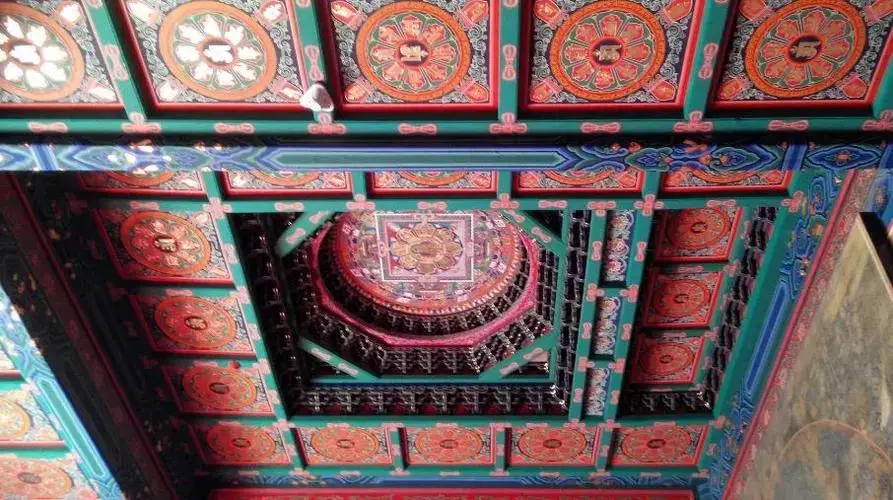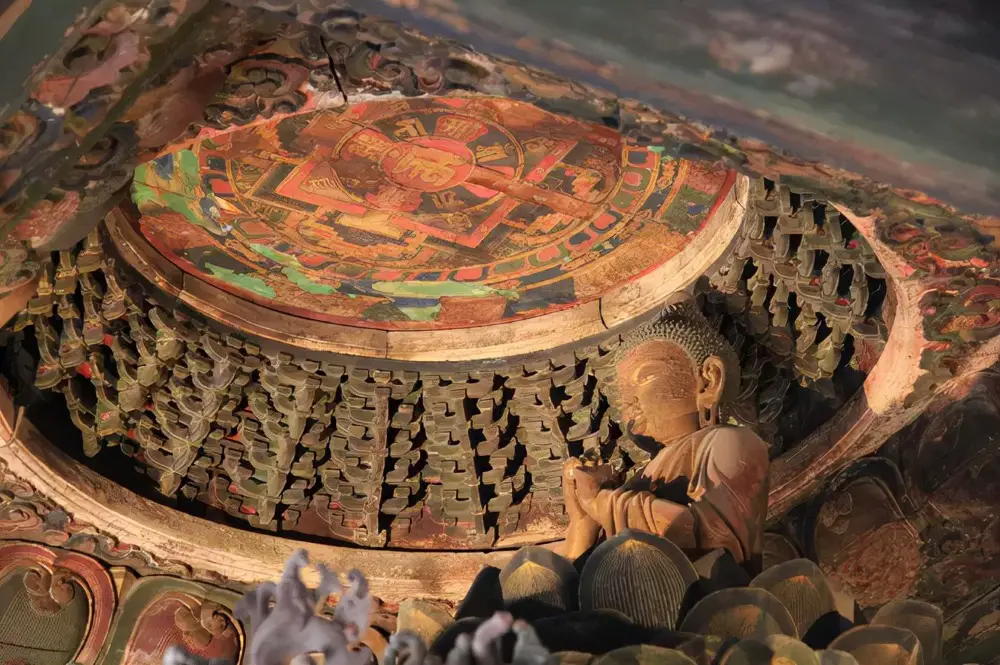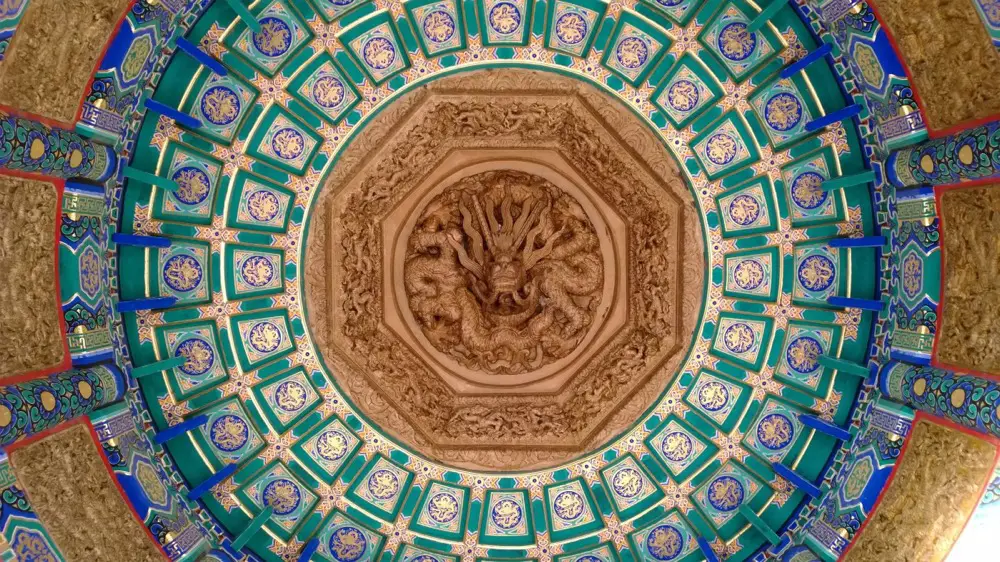A ceiling is a component used in buildings to cover the top, and a domed ceiling is specifically referred to as a “coffered ceiling.” Each square of the coffered ceiling is metaphorically called a “well” and is decorated with exquisite patterns, carvings, and paintings, hence the name coffered ceiling. This term first appeared in Han Dynasty literature. By the Qing Dynasty, the decoration of coffered ceilings often centered around dragons, hence coffered ceilings were also called “dragon wells.” In addition, Shen Kuo mentioned other aliases for coffered ceilings in his work “Dream Pool Essays · Skillful Usage,” such as “ornamental wells” and “covering the sea,” which were different names given by ancient people to coffered ceilings.
The coffered ceiling, a decorative art form commonly seen in the most prestigious ancient Chinese buildings, especially those located above deities or imperial thrones, is known as “caojing” in Chinese. Its design, typically in the shape of an umbrella, is supported by exquisite brackets, showcasing not only the loftiness of the heavens but also presenting rich visual aesthetics through techniques such as painting and relief sculptures.

The inspiration for coffered ceilings comes from the ancient astronomy concept of the Eastern Well, known as Jiu in Chinese, which is one of the twenty-eight lunar lodges, associated with the control of water sources in ancient beliefs. Therefore, setting up coffered ceilings at the highest point of halls or pavilions, adorned with lotus, water chestnut, and other aquatic plant patterns, not only mimics the celestial structure but also symbolizes the desire to suppress fire demons and protect the safety of the building. According to the “Fengsu Tong,” it is recorded, “Today, the palace is made with a caojing. The well is the image of the Eastern Well. The water chestnut is an aquatic plant. All to suppress fire.” This further confirms the close connection between coffered ceilings and fire prevention.
Structurally, coffered ceilings resemble the roof structures of ancient Chinese architecture, with the central part protruding upward and the surrounding areas sloping downward, forming an inverted trough shape. This design enhances the sense of spaciousness and depth within the cave. The coffered ceilings in Dunhuang are typical examples, simplifying the layered wooden structure of traditional Chinese ancient buildings. They place thematic works within the central square well, surrounded by layers of patterns, making them both aesthetically pleasing and profound in meaning.
Although coffered ceilings and ordinary ceilings are both forms of interior decoration, the use of coffered ceilings is strictly limited. According to Tang Dynasty regulations, residences of non-royal nobles were not allowed to use heavy coffered ceilings, further highlighting the prestigious and unique status of coffered ceilings. Therefore, coffered ceilings are not only an important part of ancient Chinese architectural art but also symbols of status and identity.
Coffered Ceiling Look Like
Coffer ceilings come in various forms, including square, octagonal, circular, etc., with complex structures. Some coffered ceilings feature exquisite and ornate carvings between each layer, using brackets, exhibiting strong decorative elements. Others, however, opt for a simpler and more straightforward approach, using stacked wooden panels, which are both elegant and concise.

In important halls such as the Hall of Supreme Harmony, the Hall of Mental Cultivation, the Hall of Central Harmony, and others within the Forbidden City, coffered ceilings adorn the areas above the imperial throne and the niches where deities are enshrined. The central part of these ceilings is decorated with coffered patterns, often crafted in the form of carved dragons with gold inlay. Although they all feature dragon carvings, each one is unique and distinct.
Surrounding the central circular dragon motif, there are twenty-four pineapple-shaped lamp holders carved along the larger circumference. Each lamp holder is connected to a red flying ribbon, leading to a circular canopy adorned with yellow, green, and red flowers on a yellow background. These twenty-four radial ribbons create a sense of depth around the coffered pattern. Expanding outward from the pineapple-shaped lamp holders is another set of concentric circles, each adorned with ninety-six lotus lamps and one hundred twenty Ma Zu statues. These lamp holders and statues gradually decrease in size from the outer to the inner circle, meticulously arranged by craftsmen to enhance the sense of depth, similar to the effect of the radial ribbons. At the origins of the twenty-four radial ribbons, there are carvings of twenty-four ancient lions, with each pair of lions flanking a Ma Zu statue, symbolizing guardianship and protection.
Coffered Ceiling classification
Coffer ceilings, as the essence of Dunhuang patterns, are situated high at the top of the grottoes. They are less prone to damage from wind, sand, and harsh natural environments, as well as human interference, resulting in their excellent preservation. Dunhuang boasts over four hundred meticulously crafted coffer ceilings.
Classification:
1. Stacked square coffer ceilings: Retaining the structure of stacked square frames from the Northern Wei Dynasty’s flat chessboard pattern, with diverse variations in the interior patterns.
2. Stem-and-lotus coffer ceilings: A unique coffer ceiling style from the Sui Dynasty, featuring an octagonal lotus at the center surrounded by intertwining stems and vines, leaning towards naturalistic forms. External decorations include circular bead patterns, vine patterns, and white bead patterns, with elaborate triangular patterns hanging down. Sui Dynasty coffer ceiling works lack standardization, presenting novel and diverse imagery, each showcasing individual creativity and charm.
3. Flying deity and lotus coffer ceilings: Featuring a broad central area, with multiple flying deities depicted flying around a large lotus flower, transcending the spatial boundaries of the cave chamber, giving viewers a sense of vast openness.
4. Twin-dragon and lotus coffer ceilings: Depicting two dragons playing with pearls on either side of the lotus flower at the center, with sixteen flying deities scattered around the coffer ceiling playing music and scattering flowers, creating a dynamic and harmonious composition.
5. Grand lotus coffer ceilings: Featuring a single large lotus flower at the center, sometimes accompanied by smaller corner flowers, with multiple layers of external decorations, presenting a concise and refreshing appearance.
Coffer ceilings are a distinctive decorative element of traditional Chinese architecture, typically featuring an upwardly projecting well-like structure with square, polygonal, or circular concave surfaces, adorned with various patterns, carvings, and paintings. They are commonly used in the most important areas above imperial thrones and deity altars in palaces and temples.
The earliest surviving wooden coffer ceiling is found atop the Guanyin Pavilion in Jixian County, built in 984 AD. It is square with the corners removed and features an octagonal pyramidal top formed by eight bracket arms. The dragon coffer ceiling atop the Hall of Supreme Harmony in the Forbidden City, Beijing, features a circular well set upon an octagonal well, with a prominent carving of a coiling dragon holding a pearl in its mouth in the center, surrounded by sixteen smaller golden dragons, making it the most luxurious coffer ceiling in Qing Dynasty architecture.
Coffered Ceiling History
After the Ming Dynasty, the construction and form of coffer ceilings underwent significant evolution, showcasing utmost intricacy and grandeur. Over time, the scale of coffer ceilings gradually expanded, with the celestial mirror symbolized at the apex becoming increasingly larger. Delicate lotus petals adorned the periphery of the celestial mirror, while vivid cloud dragon patterns were depicted at the center. This cloud dragon motif gained increasing prominence in subsequent developments, evolving into finely carved coiling dragons by the Qing Dynasty. Notably, the coiling dragons held hanging lamps in their mouths, preserving the original form of the celestial mirror while adding new visual focal points.

During the Qing Dynasty, as dragons often adorned the apex of coffer ceilings, people began to refer to them as “dragon ceilings.” This name change reflected the innovative and developmental changes in the form of coffer ceilings. Traditionally regarded as a symbol with sacred significance, coffer ceilings were primarily applied in religious or imperial architecture. In these structures, coffer ceilings were typically placed above thrones in palaces or altars in temples, becoming the most prominent and important part of the entire space.
The design of coffer ceilings not only reflects the exquisite craftsmanship of ancient artisans but also carries profound cultural connotations. From the Ming Dynasty to the Qing Dynasty, the evolution of coffer ceilings illustrates the development of ancient Chinese architectural art, reflecting people’s pursuit and imagination of heaven, sacredness, and power. Today, although the application of coffer ceilings is not as widespread as in ancient times, they remain a brilliant gem in traditional Chinese architectural art, captivating the gaze and admiration of countless individuals.
Coffered Ceiling Fire protection function
The decoration and symbolism of coffer ceilings are also related to fire prevention. According to the “Fengsu Tong,” it is recorded: “Now the palace is made into a well. The well represents the image of Dongjing. The water chestnut, lotus root, and other aquatic plants are all used to ward off fire.” Regarding Dongjing, the ancient historian Sima Qian, who wrote “Records of the Grand Historian,” a well-preserved astronomical document in China, noted: “Dongjing, eight stars govern water balance.” Dongjing, also known as the Jingxing constellation, is one of the twenty-eight constellations, consisting of eight stars, which ancient people believed governed water.
In summary, creating wells at the highest points of palaces and pavilions and decorating them with aquatic plants such as lotus, water chestnut, and lotus root are all aimed at suppressing the mischief of fire demons.
Since humans discovered fire, they have also understood its dangers. People have realized the need to avoid harm for survival and development. However, due to the low productivity at the time and the lack of effective means to control natural disasters, people could only express their wishes in various ways. The special treatment of coffer ceilings in the construction of palaces and pavilions belongs to this category. Although it is idealistic, it also reflects the ancient people’s good wishes for fire prevention.
Reference
Wang Qijun. Illustrated Structure of Chinese Architecture. Machinery Industry Press, 2016.
Shenlong Jin Xian Zijin Cheng. Do You Know How Many Dragons Are “Hidden” in the Forbidden City? China Science and Technology Net, February 13, 2024.
